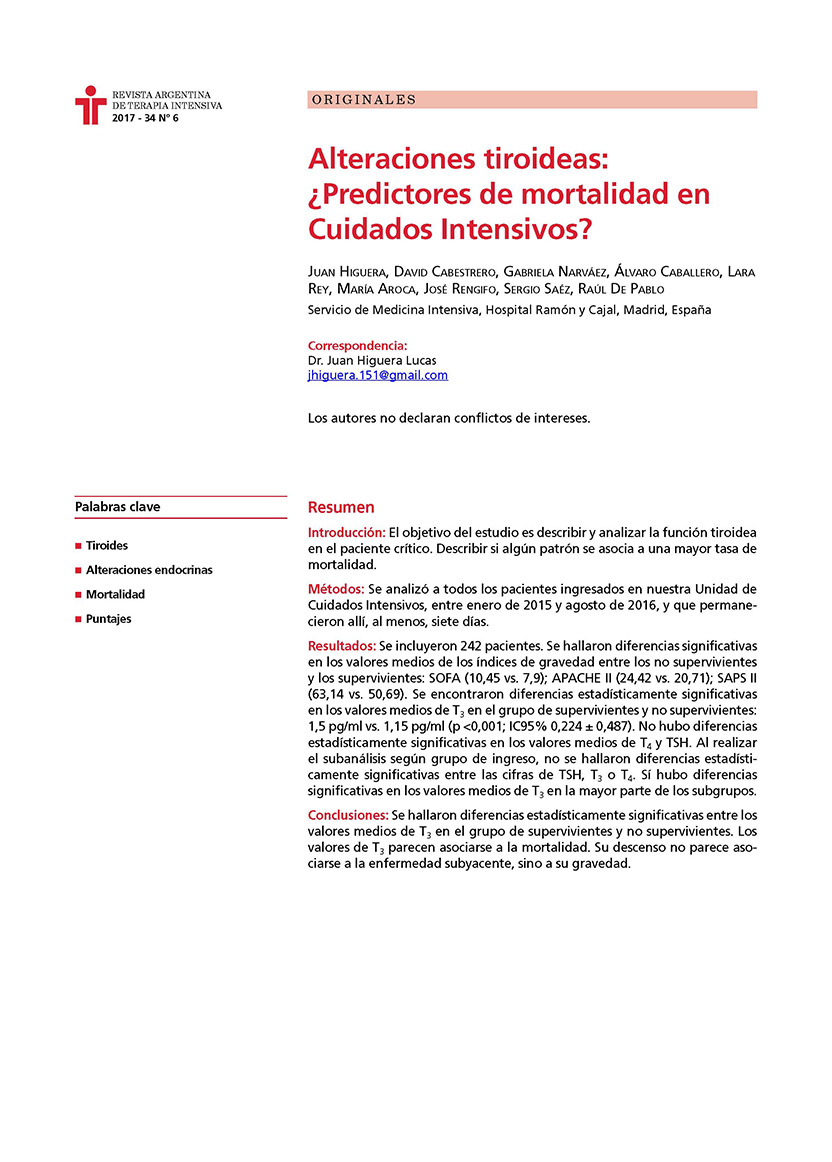Resumen
Introducción:
El objetivo del estudio es describir y analizar la función tiroidea en el paciente crítico. Describir si algún patrón se asocia a una mayor mortalidad.
Métodos:
Se analizaron todos los pacientes ingresados en nuestra unidad de cuidados intensivos entre los meses de Enero 2015 y Agosto 2016 y que permanecieron ingresados al menos siete días.
Resultados:
Se incluyeron 242 pacientes. Encontramos diferencias significativas en los valores medios de los índices de gravedad entre los no supervivientes y supervivientes. SOFA (10.45vs7.9); APACHE II (24.42vs20.71); SAPS II (63.14vs50.69). Con respecto a los valores de T3, T4 y TSH, objetivamos diferencias estadísticamente significativas en los valores medios de T3 en el grupo de supervivientes y no supervivientes. 1.5 pg/ml vs 1.15 pg/ml (p=<0.001) IC 95%. (0.224±0.487). No objetivamos diferencias estadísticamente significativas en los valores medios de T4 y TSH. Al realizar el subanálisis según grupo de ingreso, no objetivamos diferencias estadísticamente significativas entre las cifras de TSH, T3 o T4. Si objetivamos diferencias significativas en la mayor parte de los subgrupos en los valores medios de T3.
Conclusiones:
Objetivamos diferencias estadísticamente significativas entre los valores medios de T3 en el grupo de supervivientes y no supervivientes. Los valores de T3 parecen asociarse a la mortalidad. Su descenso no parece asociarse a la enfermedad subyacente sino a la gravedad.
Referencias
Rubenfeld S. Euthyroid sick syndrome. NEJM. 1978; 299:1414.
Wartofsky L. Burman KD. Alterations in thyroid function in patients with systemic illness: the “euthyroid sick syndromeâ€. Endocr. Rev. 1982; 3:164-217.
Chopra IJ. Euthyroid sick syndrome: abnormalities in circulating thyroid hormones and thyroid hormone physiology in nonthyroid illness (NTI). Med. Grand. Rounds 1982; 1:201-12.
Bermudez F, Surks MI, Oppenheimer JH. High incidence of decreased serum triiodothyronine concentration in patients with nonthyroidal disease. JCEM 1975; 41:27-40.
Kaplan MM, Larsen PR, Crantz FR, Dzau VJ, Rossing TH, Haddow JE. Prevalence of abnormal thyroid function test results in patients with acute medical illnesses. Am. J. Med. 1982;72:9-16.
Adler SM, Wartofsky L. The nonthyroidal illness syndrome. Endocrinol. Metab. Clin. North Am.2007; 36: 657–72.
Chopra IJ. Clinical review 86: Euthyroid sick syndrome: is it a misnomer? JCEM 1997; 82: (2); 329-334
Jameson, J. Larry, and Anthony P. Weetman. "Chapter 341. Disorders of the Thyroid Gland." Harrison's Principles of Internal Medicine, 18e Eds. Dan L. Longo, et al. New York, NY: McGrawHill, 2012.
Economidou F, Douka E, Tzanela M, Nanas S, Kotanidou A. Thyroid function during critical illness. Hormones 2011; 10(2):117-124.
Chopra IJ, Solomon DH, Teco GN, Eisenberg JB. An inhibitor of the binding of thyroid hormones to serum proteins is present in extrathyroidal tissues. Science 1982;215:407-9.
Angelousi AG, Karageorgopoulos DE, Kapaskelis AM, Falagas ME. Association between thyroid function tests at baseline and the outcome of patients with sepsis or septic shock: a systematic review. Eur J Endocrinol. 2011; 164(2):147–55.
Bello G, Pennisi MA, Montini L, Silva S, Maviglia R, Cavallaro F, et al. Nonthyroidal illness syndrome and prolonged mechanical ventilation in patients admitted to the ICU. Chest. 2009; 135: 1448–54.
Ture M, Memis D, Kurt I, Pamukcu Z. Predictive value of thyroid hormones on the first day in adult respiratory distress syndrome patients admitted to ICU: comparison with SOFA and APACHE II scores. Ann. Saudi Med. 2005; 25:466–72.
. Plank LD, Connolly AB, Hill GL. Equential changes in the metabolic response in severely septic patients during the first 23 days after onset of peritonitis. Ann. Surg. 1998; 228: 146-158.
Rothwell PM, Lawler PG. 1995 Prediction of outcome in intensive care patients using endocrine parameters. Crit. Care Med. 1995; 23:78–83.
Peeters RP, Wouters PJ, Van Toor H, Kaptein E, Visser TJ, Van den Berghe G, 2005 Serum 3,3’,5’triiodothyronine (rT3) and 3,5,3’-triiodothyronine/rT3 are prognostic markers in critically ill patients and are associated with postmortem tissue deiodinase activities. JCEM. 2005; 90: 4559-65.
Peeters RP; Kester MHA; Wouters PJ; Kaptein E; Van Toor H; Visser TJ; et al. Increased thyroxine sulfate levels in critically ill patients as a result of a decreased hepatic type I deiodinase activity. JCEM. 2005; 90: 6460-65.
Chopra IJ, Huang TS, Beredo A, Solomon DH, Chua Teco GN, Mead JF. Evidence for an inhibitor of extrathyroidal conversion of thyroxine to 3,5,3΄-triiodothyronine in sera of patients with nonthyroidal illnesses. JCEM 1985; 60: 666-72.
Arem R, Wiener GJ, Kaplan SG, Kim HS, Reichlin S, Kaplan MM. Reduced tissue thyroid hormone levels in fatal illness. Metabolism 1993; 42: 1102-08.
Ricart-Engel W, Fernandez-Real JM, Gonzalez-Huix F, del Pozo M, Mascaro J, Garcia-Bragado F. The relation between thyroid function and nutritional status in HIV-infected patients. Clin. Endocrinol. 1996; 44: 53-8.
Chopra IJ, Williams DE, Orgiazzi J, Solomon DH. Opposite effects of dexamethasone on serum concentrations of 3,3΄,5΄triiodothyronine (reverse T3) and 3,3΄5-triiodothyronine (T3). JCEM 1975; 41: 911-20.
Afandi B, Vera R, Schussler GC, Yap MG. Concordant decreases of thyroxine and thyroxinebinding protein concentrations during sepsis. Metabolism. 2000; 49: 753-54.
Chinga-Alayo E, Jaime Villena J, Arthur T, Evans AT, Mirko Zimic M. Thyroid hormone levels improve the prediction of mortality among patients admitted to the intensive care unit. Intensive Care Medicine. 2005; 31: 10 1356-61.
Slag MF, Morley JE, Elson MK, Crowson TW, Nuttall FQ, Shafer RB. Hypothyroxinemia in critically ill patients as a predictor of high mortality. JAMA 1981; 245:43–5.
Takala J, Ruokonen E, Webster NR, Nielsen MS, Zandstra DF, Vundelinckx G, et al. Increased mortality associated with growth hormone treatment in critically ill adults. NEJM 1999; 341:785–92.
Brent GA, Hershman JM. Thyroxine therapy in patients with severe nonthyroidal illnesses and low serum thyroxine concentration. JCEM. 1986; 63(1):1-8.
Van den Berghe G, de Zegher F, Baxter RC, Veldhuis JD, Wouters P, Schetz M et al. Neuroendocrinology of prolonged critical illness: effects of exogenous thyrotropin-releasing hormone and its combination with growth hormone secretagogues. JCEM. 1998; 83(2):309-19.
Mebis L, Van den Berghe G. Thyroid axis function and dysfunction in critical illness. Best Pract Res Clin Endocrinol Metab. 2011; 25:745–57.
La revista no retiene los derechos de reproducción (copyright) por lo que los autores pueden volver a publicar sus trabajos con la sola mención a la fuente original de publicación.

